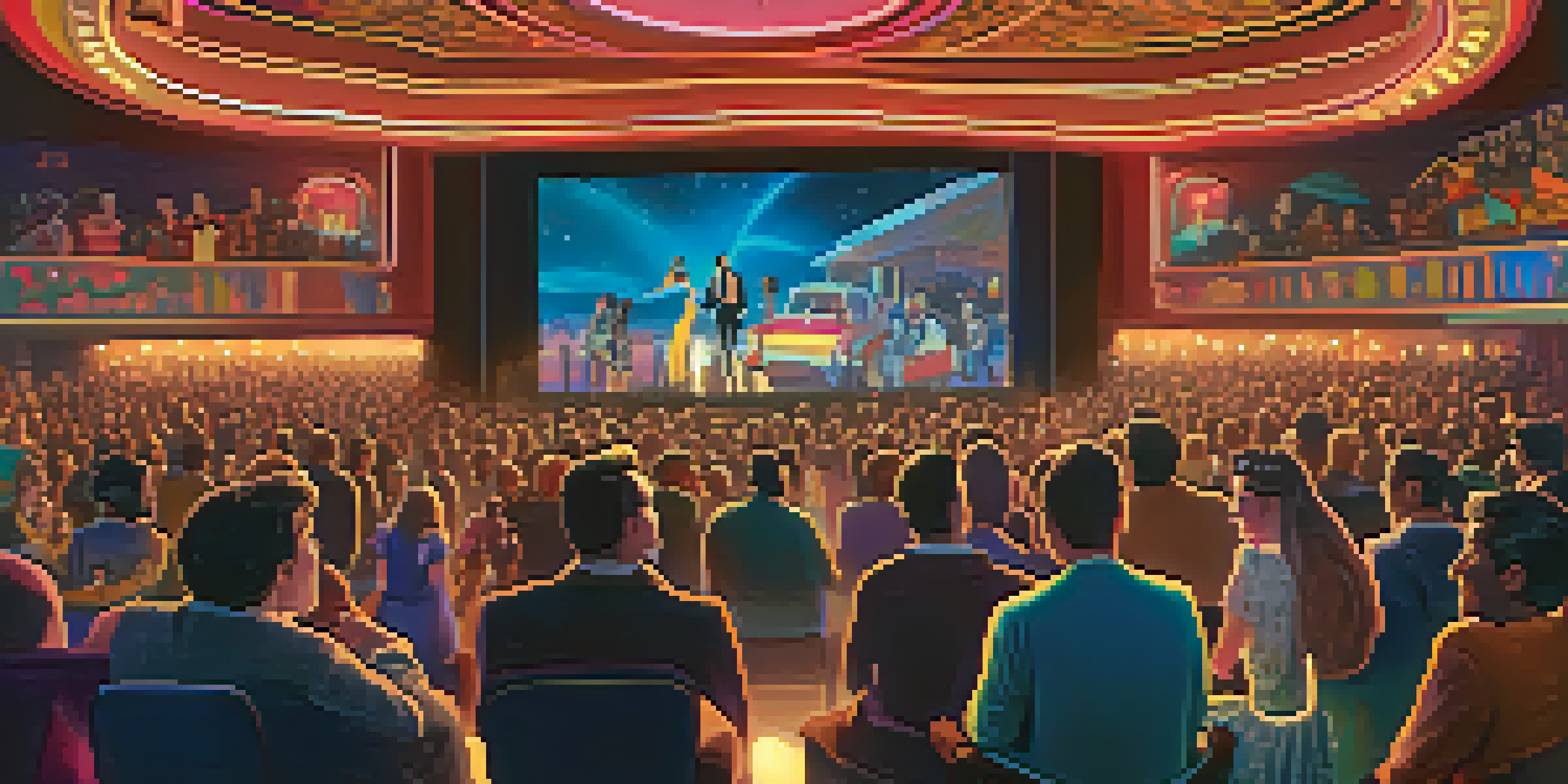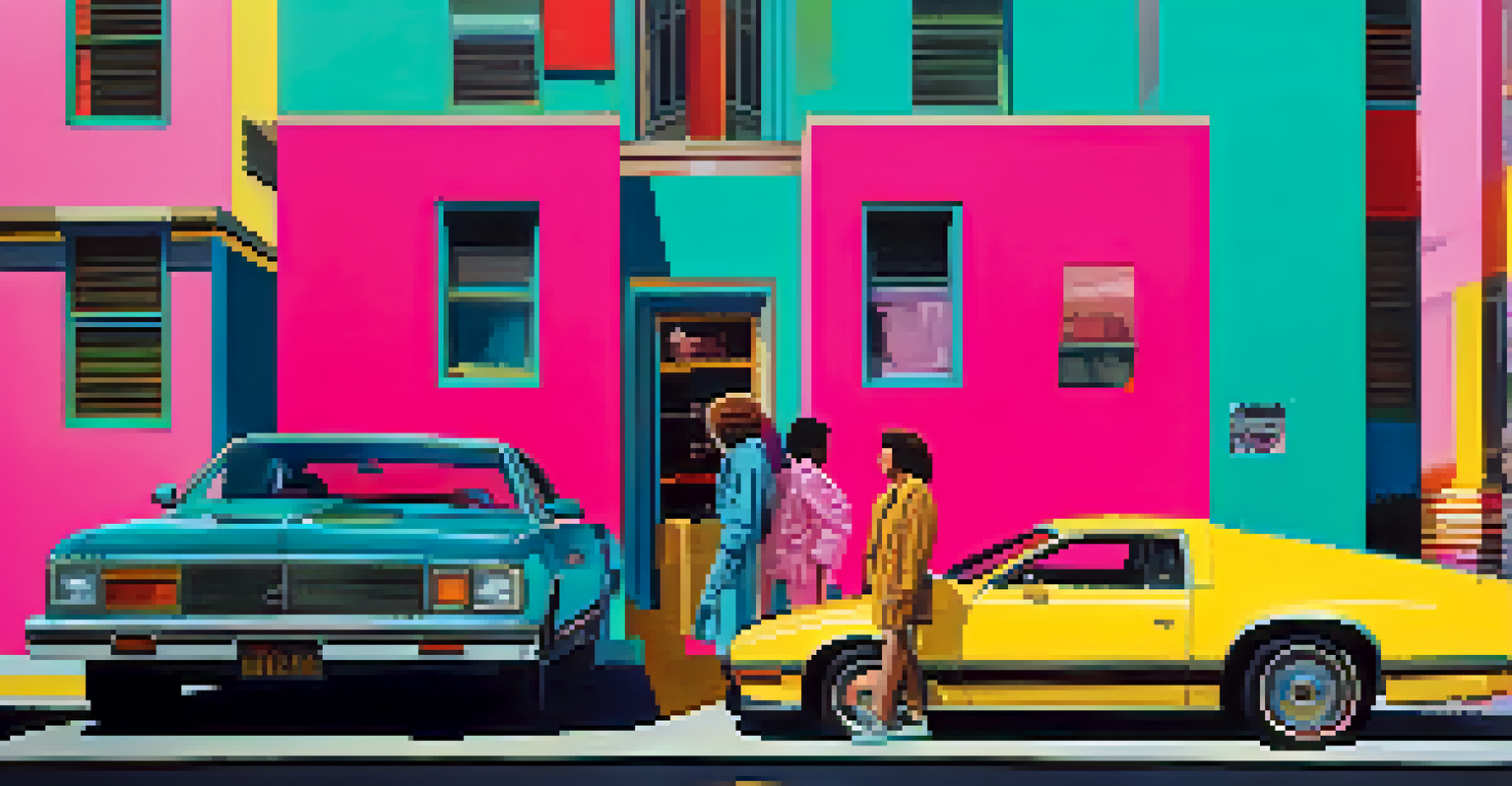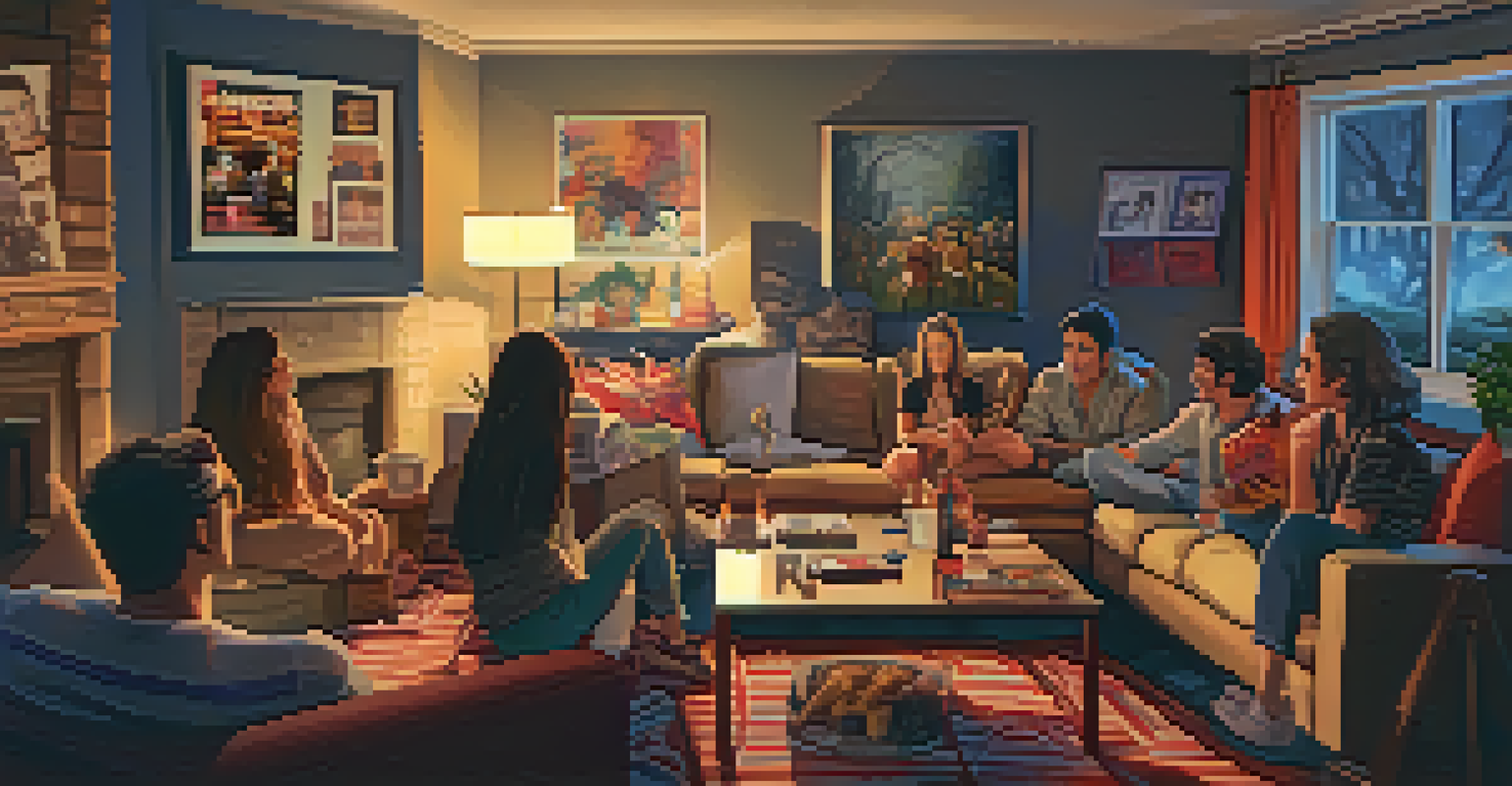The Evolution of Cult Classic Films Through Decades

Defining Cult Classics: A Cinematic Phenomenon
Cult classic films are those unique pieces of cinema that develop a dedicated fanbase, often despite initial box office failures. They resonate with audiences for their unconventional storytelling, quirky characters, or memorable quotes, creating a cultural impact that lasts for years. Think of movies like 'The Rocky Horror Picture Show' or 'Donnie Darko' that have become beloved treasures, celebrated through midnight screenings and fan gatherings.
Cult movies are the closest thing we have to a modern folk art.
The essence of a cult classic often lies in its ability to connect with viewers on a personal level. These films frequently challenge societal norms or explore taboo subjects, which can lead to an intense appreciation among niche audiences. This deep-seated connection often transforms a simple viewing experience into a communal event, with fans sharing their love through discussions and creative expressions.
As we navigate through the decades, the definition of a cult classic has evolved, influenced by changing cultural landscapes, technology, and audience preferences. The journey of these films reflects broader societal shifts, making them not just entertainment but also important cultural artifacts.
The 1950s: Birth of the Cult Classic
The emergence of cult classics can be traced back to the 1950s, a time when Hollywood was exploring new themes and breaking away from traditional storytelling. Films like 'Rebel Without a Cause' encapsulated the teenage angst of the era, offering a rebellious spirit that resonated with young audiences. James Dean became an icon, and his portrayal of disaffected youth sparked a cultural movement that would define a generation.

During this decade, horror films also began to carve out their own niche, with titles like 'Plan 9 from Outer Space' gaining notoriety for their low budgets and unintentional humor. While these films may not have been successful upon release, they have since gained cult status due to their sheer audacity and charm. They proved that a film's legacy could often grow beyond its initial reception.
Cult Classics Connect Communities
Cult classic films resonate deeply with audiences, transforming simple viewings into communal experiences that foster discussions and creative expressions.
The 1950s set the stage for what would become a rich tapestry of cult cinema, blending elements of rebellion, horror, and youth culture that would influence filmmakers for decades to come. This decade laid the groundwork for a new kind of storytelling that would continue to evolve.
The 1960s: Counterculture and Experimentation
As the 1960s rolled in, the cultural landscape shifted dramatically, driven by counterculture movements and social upheaval. This era saw the rise of films like 'Easy Rider,' which captured the spirit of freedom and rebellion, appealing to a generation seeking change. The film's unconventional narrative and vibrant visuals resonated deeply with audiences, establishing it as a cornerstone of cult cinema.
A cult film is a movie that has a dedicated fanbase, often despite not being mainstream or critically acclaimed.
Moreover, the experimental nature of films during this decade opened doors for unconventional storytelling. Directors like Andy Warhol pushed boundaries with films like 'Chelsea Girls,' challenging viewers to rethink the very nature of cinema. These films often polarized audiences but ultimately contributed to the diverse landscape of cult classics.
The 1960s not only embraced counterculture but also showcased the power of film as a medium for social commentary. This era's films remain relevant, reflecting the ongoing struggle for identity and individuality, and their influence can still be felt in today's cinema.
The 1970s: The Rise of the Midnight Movie
The 1970s introduced the concept of the 'midnight movie,' where unconventional films found their audience in late-night screenings. This movement was epitomized by 'The Rocky Horror Picture Show,' which became a cultural phenomenon with its interactive audience participation. Fans would dress up, shout lines, and even bring props, turning a simple movie viewing into a vibrant theatrical experience.
Additionally, the 1970s produced a wealth of films that defied mainstream conventions, such as 'A Clockwork Orange' and 'Eraserhead.' These films captivated audiences with their surreal visuals and provocative themes, cementing their status as cult classics. They challenged viewers to engage with complex ideas and emotions, sparking discussions that extended far beyond the cinema.
Decades of Evolving Themes
The definition of cult classics has shifted over the decades, reflecting broader societal changes and diverse storytelling approaches.
The midnight movie trend not only provided a platform for these films but also created a community of devoted fans. This decade solidified the notion that films could be both entertaining and thought-provoking, enriching the cultural landscape in ways that continue to influence filmmakers today.
The 1980s: Quirky Characters and Genre Blending
In the 1980s, cult classics began to embrace quirky characters and genre blending, resulting in some of the most memorable films of all time. Movies like 'The Breakfast Club' and 'Ferris Bueller's Day Off' captured the essence of teenage life, with relatable characters that audiences could connect with. These films highlighted the struggles and triumphs of youth, creating a lasting impact that resonates with generations.
Simultaneously, the horror genre saw a surge in cult classics like 'The Evil Dead' and 'Re-Animator,' which combined humor with scares. Filmmakers like Sam Raimi and Stuart Gordon pushed the boundaries of the genre, creating films that were both entertaining and innovative. Their ability to blend humor and horror opened new avenues for storytelling, attracting diverse audiences.
The 1980s solidified the idea that cult classics could emerge from any genre, as long as they offered something fresh and engaging. This decade not only expanded the definition of what a cult classic could be but also showcased the power of creativity in filmmaking.
The 1990s: Internet Impact and Indie Revival
The advent of the internet in the 1990s transformed how audiences discovered and celebrated cult classics. Websites and online forums allowed fans to connect, share their love for films like 'Clerks' and 'The Big Lebowski,' and create vibrant communities around them. This newfound accessibility helped propel many independent films into the cult classic sphere, showcasing the power of grassroots movements in cinema.
Additionally, the 1990s saw a rise in films that combined humor and absurdity, such as 'The Room' and 'Fight Club.' These films, while polarizing, attracted passionate fanbases that relished in their unconventional narratives and quotable lines. The era's unique films often sparked discussions about identity, consumerism, and societal norms, engaging audiences in deeper conversations.
Internet's Role in Cult Film Culture
The rise of the internet in the 1990s revolutionized how fans discovered and celebrated cult classics, creating vibrant online communities around them.
As the internet continued to evolve, it facilitated the sharing of cult films across borders, allowing international gems like 'Trainspotting' and 'Run Lola Run' to find their place in the cult classic narrative. This decade highlighted the importance of community in film appreciation, emphasizing how shared experiences can elevate a film's status.
The 2000s: Nostalgia and New Franchises
The 2000s brought a wave of nostalgia, with audiences yearning for the quirky charm of earlier cult classics. Films like 'Napoleon Dynamite' and 'Shaun of the Dead' embraced idiosyncratic humor, capturing the essence of what made cult classics so beloved. These films resonated with viewers who sought authenticity and originality in a world of blockbuster sequels and remakes.
Moreover, this decade saw the rise of franchises that developed cult followings, such as 'Harry Potter' and 'The Lord of the Rings.' While these films were widely successful, they also fostered dedicated fanbases that engaged in discussions, fan art, and conventions. This blending of mainstream success with cult status created a unique dynamic in the film industry.

The 2000s highlighted the balance between nostalgia and innovation, as filmmakers paid homage to past classics while creating new ones. This era reinforced the idea that cult classics could emerge from any genre, as long as they resonated with audiences on a personal level.
The 2010s and Beyond: Streaming and Global Influence
With the rise of streaming platforms in the 2010s, accessibility to cult classics reached new heights. Audiences could now explore a vast array of films from different cultures and genres, leading to the emergence of global cult classics like 'Parasite' and 'The Intouchables.' This democratization of film viewing allowed for a richer tapestry of storytelling, showcasing diverse voices and experiences.
Additionally, social media played a crucial role in the appreciation and promotion of cult classics. Platforms like Twitter and Instagram became spaces for fans to share their love for films, create memes, and engage in discussions. This online presence has helped revive interest in older cult classics and elevate newer films to cult status, showcasing the power of community in the digital age.
As we move forward, the landscape of cult classics continues to evolve, driven by changing audience preferences and technological advancements. The future of cult cinema promises to be as diverse and engaging as ever, reflecting the complexities of our modern world while maintaining the charm that captured our hearts.